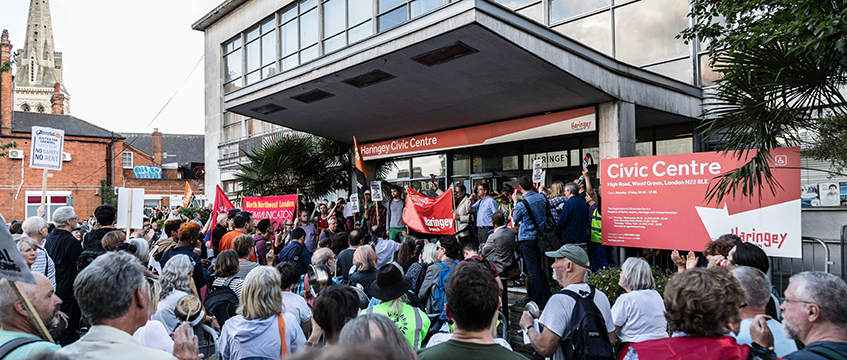Haringey approves £2bn Lendlease development vehicle
Haringey Council’s executive has approved a partnership with Lendlease for a £2bn development vehicle it hopes will deliver 6,400 homes and a new town centre, despite strong local and national opposition.
The joint venture was approved at a cabinet meeting last night after more than three hours of debate between councillors, residents and community leaders.
Protestors chanted and waved placards outside the town hall before breaking through metal barriers and attempting to enter the building. However, chants of “social housing not social cleansing” and “Labour or Tory same old story” went unheard as the Labour council approved the vehicle just before 10pm, ending a two-year process of negotiation and consultation.
Haringey Council’s executive has approved a partnership with Lendlease for a £2bn development vehicle it hopes will deliver 6,400 homes and a new town centre, despite strong local and national opposition.
The joint venture was approved at a cabinet meeting last night after more than three hours of debate between councillors, residents and community leaders.
[caption id="attachment_884201" align="aligncenter" width="775"] Protesters against the Haringey Development Vehicle[/caption]
Protestors chanted and waved placards outside the town hall before breaking through metal barriers and attempting to enter the building. However, chants of “social housing not social cleansing” and “Labour or Tory same old story” went unheard as the Labour council approved the vehicle just before 10pm, ending a two-year process of negotiation and consultation.
Opposition to the development vehicle is predicated on three key areas: privatisation of public assets; scepticism over displaced residents’ “right to return”; and concerns about whether councillors will have the authority to hold “big business” to account on areas such as affordable housing.
Haringey promises to rehouse any displaced residents within the borough on similar rents and with the same tenancy rates. It has also committed the vehicle to delivering a minimum of 40% affordable homes. The council will contribute land and assets as its own equity stake and Lendlease will match this with its own funds. Since both parties will have a 50% control of the HDV, neither side should be forced into a position it opposes.
Debate around the vehicle has intensified since the fire at Grenfell Tower in Kensington provoked a wider debate about the state of the nation’s social housing. In a letter to Haringey Council yesterday, MP for Tottenham David Lammy called on the cabinet to pause its decision in light of the fire and to “reflect further on whether entering into a public-private partnership is the correct decision for the borough”.
Haringey’s overview and scrutiny committee has recommended that a wholly council-owned housing company to purchase and own HDV social and affordable homes is considered. Responding to concerns last night, Alan Strickland, Haringey’s cabinet member for housing and regeneration, said the public inquiry into Grenfell would be completed by the time the first HDV homes were built, so they would comply with any updated building regulations.
In an attempt to appease the anti-capitalist contingent of the opposition, he said the HDV was a demonstration of direct market intervention, breaking the cycle of rising land prices from developers speculating and selling to each other.
The public and politicians are right to raise concerns about regeneration when it means communities will be disbanded. A local reverend speaking at the cabinet meeting last night pointed to the impact on mental health caused by estate regeneration. His speech charted the changing policy on social housing since the 1970s and called for the introduction of a land value tax and new definition of affordable housing linked to income rather than the market. “You are creating a financial crisis in the homes of the most deprived,” he said.
However, the high number of homeless families in the borough and too many people living in poor quality homes means the council needs to take action. Housing charity Shelter has conceded the borough does not have a “do nothing” option.
After going through the 1,500-page report on the HDV released five days before the meeting, one opposition councillor said: “A bad deal is not better than no deal.”
Liberal Democrat councillors are expected to call in the motion, and a crowdfunding campaign has already been launched to help fund a judicial review.
Public opposition to private developers and scepticism around regeneration is growing, and Haringey Council could still face a number of pitfalls. However, with the right level of scrutiny, the vehicle could be proof that public-private partnerships can build genuinely affordable homes while jointly benefiting from making a profit in the capital.
To send feedback, e-mail Louisa.Clarence-Smith@egi.co.uk or tweet @LouisaClarence or @estatesgazette
Photo © Matthew Chattle/REX/Shutterstock











